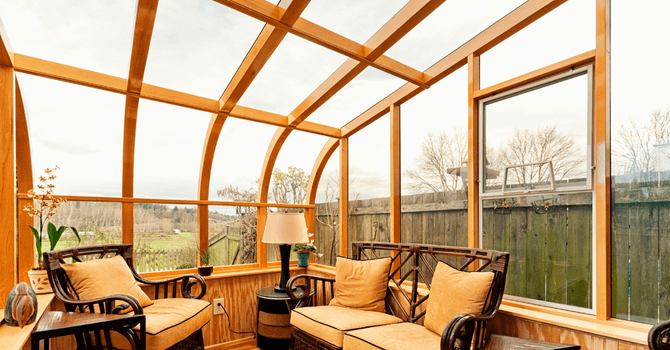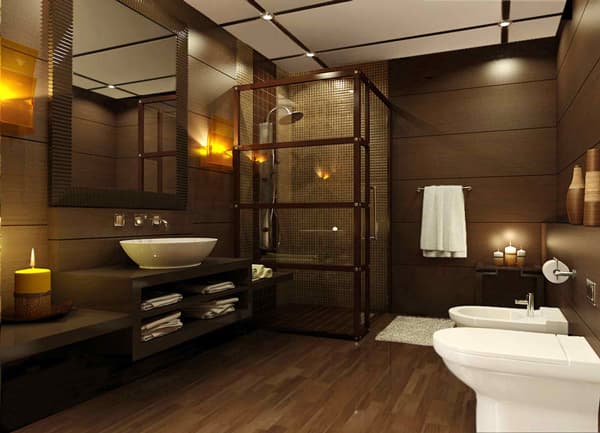How to Build a Sunroom for Your House
By Editorial Team
Updated on December 2, 2024

A sunroom is an area that’s conducive to rest and relaxation. However, don’t read too much into the name, it can very well be used beneficially either during the summertime or wintertime, day or night. On top of increasing the resale value of your house, a sunroom means adding an enclosed space on your property to prolong those beautiful, warm days.
Did you know that the word sunroom comes from the word "solarium," which in Latin is broken down into two words: sol (sun) and arium (place or thing used for)? A sunroom is a glass-enclosed space that allows you to connect with nature, while still being in the comfort of your own home. Contractor Jacob Gauthier, Auvents et Solariums Signature, explains that “Sunrooms have several advantages, serving as rain, wind, snow, and insect shields, while also adding square footage to your home.” So, why build one? What should you consider prior to undertaking such a project? We have answers to all your questions.
What's the difference between a sunroom and a veranda?

Source: Canva
First off, we’ll start by explaining the difference between a sunroom and a veranda, thereby squashing any confusion or ambiguity between the two. These two structures have the following features in common: they’re attached to a house and allow you to enjoy the sunshine for an extended period.
However, there are some differences between the two: a veranda is a living space attached to a house that has large windows; and oftentimes, it’ll have a bay window or a curtain wall (window wall). It has aluminum walls with flexible polymer windows, from top to bottom. Said structure is a little bit more lightweight compared to a sunroom. As for a sunroom, it’s an entirely glassed-in enclosure without openings. It has aluminum structural components and sliding windows. It’s typically built onto a deck or balcony. “For an additional year-round living space, a (4-season) sunroom is ideal,” advises contractor Jacob Gauthier, from Auvents et Solarium Signature.
Choose the Sunroom’s Orientation

Source: Canva
If you decide to build a sunroom, the first question you should ask yourself is about its positioning. Thereby, wisely choose which direction the sunroom should face since sunlight and heat gain both vary from one hemisphere to the other.
North- or South-Facing Sunroom
This idea that a north-facing sunroom suffices is a misconception since the amount of sunlight will be greatly reduced. This will, without fail, affect the building costs since the sunroom will need extra insulation. And, if you decide to neglect insulation, the energy costs will be greatly impacted, which really isn’t a good investment.
Similarly to a north-facing sunroom, a south-facing one isn’t much better, especially during summer. In fact, since the sun’s beaming down directly onto the sunroom, it'll rapidly become stuffy, and that’s rather hard to control. Also, it’s not a very energy-efficient idea, considering that you’ll most definitely need to invest in big windows and an air conditioning system, which will lead to soaring building costs.
Why’s it best to have an east- or west-facing sunroom?
Drawing a parallel from that of building a house, likewise, the sunroom should face either east or west to have better sun exposure and reduce energy needs. To choose between the two, simply ask yourself whether you plan on using your sunroom in the mornings (east) or the afternoons (west).
A 3- vs. 4-Season Sunroom

Source: Canva
There are two types of sunrooms on the market right now: the 3-season sunroom and the 4-season sunroom. The differences between the two can be distinguished with respect to wanting to use this new space during the wintertime or not. A three-season sunroom will suit your needs perfectly if your end goal is to fully benefit from the spring and fall, as well as the summer heat.
Note that there are various models of three-season sunrooms. The polymer sunroom, oftentimes preferred due to its rather competitive price point, will allow you to fully benefit from a bright and enjoyable space during the warmer seasons. You can also purchase a standard, three-season sunroom, which consists of an aluminum and glass structure.
As for the four-season sunroom, it’s an entirely insulated and heated space. It’s about 30% more expensive than a three-season sunroom, but you’ll be able to benefit from it 365 days a year. Its structure is also made of aluminum, but it’s also possible to cover it with cedar plywood. Here are the differences to consider regarding the two models:
Four-Season Sunroom
Used year-round
More expensive than a 3-season sunroom due to its building materials
Has sturdy foundations since it’s a relatively heavy structure
Is ventilated, heated, and insulated
Three-Season Sunroom
Easier DIY installation compared to the above-mentioned model
Lighter structure (often made with extruded aluminum)
Has single-pane tempered glass
Can be installed directly on a deck or concrete slab
How much does a sunroom cost?

Source: Canva
Naturally, the cost of a sunroom will depend on its dimensions and the materials you choose to use to build it. “Several factors will come into play, influencing the cost of a sunroom based on the materials used, its size, and different installation options,” further explains Gauthier from Auvents et Solariums Signature. Expect to pay at least $20,000 for a turnkey installation, meaning a two-section, 10-inch by 15, sunroom made of glass walls, extruded aluminum structural screw piles, and a conventional, insulated roof (price doesn’t include the foundation nor the floor).
You can also build this type of sunroom model yourself if you’ve got the right skill set to handle this type of project. That way, you can save between 25% and 40% of the building costs. Solely building materials will be charged, meaning about $10,000 from a retailer, where you’ll likely be able to get all the necessary information to bring your project to fruition, step by step.
Building a Sunroom According to By-Laws
Note that, to build a sunroom, you’ll need a general or specialized contractor licence issued by the Régie du bâtiment du Québec (RBQ), or from your provincial equivalent. A sunroom, being an integral part of your home, is a new construction that must be built according to the standards and by-laws issued by the Construction Code. Here are a few examples of requirements mandated as part of your sunroom construction project:
A sunroom can be a combustible construction solely when the building in question is of combustible construction.
Depending on the building in which it’s built, a sunroom’s structural components must be fireproof as indicated by the by-law.
Building a sunroom is an extension of the floor space and could require making changes to the house’s structure as a whole.
Depending on its purpose, the sunroom must comply with the construction standards established with regard to building façades and clearance space between structures.
The sunroom’s door must comply with standards in regard to exits. It could mean installing a door that swings on a vertical axis if the sunroom is considered an emergency exit.
The sunroom must be equipped with the same fire protection as the building in which it’s built, meaning possibly having, in some cases, a sprinkler system.
The framework must be frost-proof; the roof’s structure must withstand various loads as defined by the Construction Code (wind, snow, etc.), whatever the model, standard or other.
A sunroom must be connected to a light source or a functioning outlet on the switchboard if used as a living space; the height of the ceiling must comply with that issued by the Construction Code.
Get 3 renovation quotes for your door and windows project
RenoQuotes.com can help you get quotes for your door and windows project. By submitting your project, we’ll put you in contact with top-rated contractors. Fill in the form on the homepage (it only takes a few minutes), and you will get estimates from trusted professionals.
Dial 1-844 828-1588 to speak with one of our customer service representatives.
Looking for something else?
Related articles
The latest industry news, interviews, technologies, and resources.

Amanda Harvey
•15 Jun 2025
A balcony is a beautiful addition to any home, a portal to the outside world at the touch of your fingertips, and a way to get some fresh air without leaving the house. However, since balconies are stuck outside day and night, they face deterioration and damage caused by various natural elements.

Editorial Team
•07 Nov 2023
We can’t deny that painting usually turns out to be a time-consuming activity. Most homeowners love the idea of a fresh coat of paint, but the process of getting there can be tricky. This labour-intensive job needs attention to detail and perseverance, especially if you’re dealing with the age-old debate of how many coats of paint are necessary.

Léa Plourde-Archer
•06 Aug 2025
As a contractor, the trust-based relationship that you build with your customers is essential to your success and to the growth of your company. If you are already a member of our network, you've probably taken the time to fill out your profile page.

Editorial Team
•07 Nov 2023
Considering updating your bathroom but unsure where to start? A bathroom is one of the most used spaces in a house and as such, it should be both comfortable and functional. Being that it’s so frequently used, an ideal bathroom is one which doesn’t wear out easily and makes use of materials that stand up over time.

Editorial Team
•07 Nov 2023
Basements today have become very valuable spaces within the home. Whether it’s a recreational space to relax or has extra bedrooms or storage space, making the best use out of your basement is ideal. An added plus to remodelling your basement is that it’s a great return on your investment, with the average return being anywhere from 50 to 75 percent.